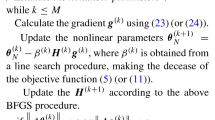Abstract
Efficient linear separation algorithms are important for pattern classification applications. In this paper, an algorithm is developed to solve linear separation problems in n-dimensional space. Its convergence feature is proved. The proposed algorithm is proved to converge to a correct solution whenever the two sets are separable. The complexity of the proposed algorithm is analyzed, and experiments on both randomly generated examples and real application problems were carried out. While analysis shows that its time complexity is lower than SVM that needs computations for quadratic programming optimization, experiment results show that the developed algorithm is more efficient than the least-mean-square (LMS), and the Perceptron.
Similar content being viewed by others
References
Burges C J C. A tutorial on support vector machines for pattern recognition. Data Min Knowl Disc, 1998, 2: 121–167
Duda R, Hart P, Stork D. Pattern Classification. 2nd ed. New York: John Wiley & Sons, Inc., 2001
Kung S Y. Digital Neural Networks. Upper Saddle River, NJ: Prentice-Hall, 1993
Rosenblatt F. The perceptron: A probabilistic model for information storage and organization in the brain. Psychol Rev, 1968, 65: 386–408
Vapnik V N. The Nature of the Statistical Learning Theory. Berlin: Springer, 1995
Widrow B, Walach E. On the statistical efficiency of the LMS algorithm with nonstationary inputs. IEEE Trans Inf Theory, 1984, 30: 211–221
Tsang I, Kwok J, Cheung P. Core vector machines: fast SVM training on very large data sets. J Mach Learn Res, 2005, 6: 363–392
Kim J H, et al. The geometrical learning of binary neural networks. IEEE Trans Neural Netw, 1995, 6: 237–247
Zhang D. Parallel VLSI Neural System Designs. Singapore: Springer-Verlag, 1999
Huang J Y. A quasi-physical algorithm for solving the linear separation problem in n-dimensional space. J Cent South Univ Tech, 2001, 8: 272–277
Huang W, Wang G. A quasi-mechanical method for solving the rectangle covering problem-an approach to tackling NP hard problems. Graphic Mod Image Process, 1994, 56: 209–308
Huang W. A quasi-physical method for solving the covering problem-an approach to tackling NP-hard problems. Chinese J Comput, 1989, 12: 610–616
Li W, Huang W. A mathematic-physical approach to the satisfiability problem. Sci China Ser A, 1995, 38: 116–128
Author information
Authors and Affiliations
Corresponding author
Rights and permissions
About this article
Cite this article
Liu, Z., Zhang, D. & Li, Y. Fast and convergence-guaranteed algorithm for linear separation. Sci. China Inf. Sci. 53, 729–737 (2010). https://doi.org/10.1007/s11432-010-0037-5
Received:
Accepted:
Published:
Issue Date:
DOI: https://doi.org/10.1007/s11432-010-0037-5




